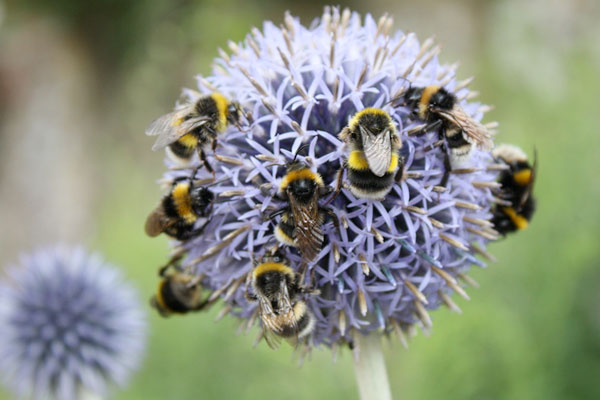Bees are one of the most important pollinators in the world. In addition to providing us with honey and beeswax, three quarters of the world's food sources require pollinators.
Pollination also occurs with activity from butterflies, hummingbirds and other insects, birds and animals.
Habitat loss and increased use of pesticides is contributing to the loss of bees and other pollinators. Create your own bee and pollinator friendly garden by using native flowering plants and decrease use of harmful pesticides.
Bees eat nectar for energy and pollen for protein and fats. Native and heirloom plants contain the most nutrients. Wildflower gardens are very attractive to our pollinators. Here are some tips on helping out these all-important pollinators:
Single flowers (those with one ring of petals) provide more nectar and pollen than double flowers, in which extra petals have replaced pollen full anthers. Double flowers also make it more difficult for bees to reach the inner flower parts.
Different pollinators are active at different times of year, so include a variety of plants that bloom from early spring through late fall. To attract the full range of pollinators, choose plants of various heights, including flowering trees and shrubs, and plants with a variety of flower shapes and sizes.
Flowers that Bees Love:
-
Alyssum
-
Achillea (yarrow)
-
Agastache (anise hyssop)
-
Asclepias (butterfly weed)
-
Borage
-
Coreopsis
-
Echinacea (coneflower)
-
Echinops (globe thistle)
-
Geranium (cranesbill)
-
Helianthus (sunflower)
-
Lavender
-
Liatris (blazing star)
-
Lonicera (honeysuckle)
-
Monarda (bee balm)
-
Papaver (poppies)
-
Penstemon
-
Rudbeckia (black-eyed Susan)
-
Trifolium (clover)
Trees and Shrubs that Bees Love:
-
Chokecherry
-
Dogwood
-
Elderberry
-
Hawthorn
-
Snowberry
-
Pin Cherry
-
Willow
Color:
Bees find blue, purple and yellow flowers most appealing. Flat or shallow blossoms, such as daisies, zinnias, asters and Queen Anne's lace, will attract the largest variety of bees. Long-tongued bees will be attracted to plants in the mint family, such as nepeta, salvia, oregano, mint and lavender. Long-tongued bumblebees are attracted to flowers with hidden nectar spurs, such as larkspur, monkshood, monarda, columbine and snapdragons.
Avoid using pesticides:
Many pesticides — even organic ones — are toxic to bees and other pollinators. Use cultural techniques to control pests, such as crop rotation and row covers, as well as nontoxic controls, such as trapping and hand-picking. If you choose to use pesticides, use them only as a last resort. Choose targeted pesticides, such as Bt for caterpillars (keep in mind this kills butterfly larvae as well). To protect pollinators, do not use pesticides on open blossoms or when bees or other pollinators are present.

